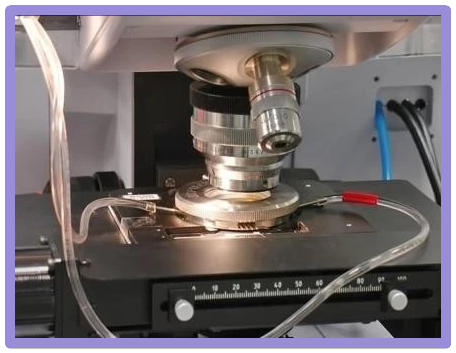We have a number of liquid cells available. Please contact a Beamline Scientist if you are considering a liquid cell for your experiment. NOTE: The PC2 laboratory is available for loading of the liquid cells as required for certain biological samples. Liquid Flow-Through Cell A Bioptechs flow cell designed for light microscopy has been adapted for FTIR microspectroscopy. The cell uses 40 mm windows, with a 2 mm thick drilled bottom window and a 1 mm thick standard top window. We currently have CaF2 available with ZnS windows ordered and awaiting delivery. The design uses a peristaltic pump to flow a film of media around live biological cells. Their response to changes in this media can then be measured in almost real time. Please contact a Beamline Scientist if you wish to use this sample holder. For more details on the cell itself, please see the Bioptechs website.  Figure: Bioptechs liquid flow-through cell | Note |
|---|
Liquid Compression Cell A major restriction to studying living systems by infrared is the strong absorbance of water in the mid-IR region which overlays the amide I band (1650 cm-1) of proteins and complex biological materials. This limits measurements to samples with a path length of <10 μm, however a liquid cell designed at the Australian Synchrotron enables the collection of high quality, mid-IR spectra of live cells at these small path lengths. The design utilises a micro-compression cell to sandwich biological cells between two calcium fluoride windows (13 mm in diameter), one of which is printed with a micro-fabricated spacer approximately 6 μm in thickness. The S-channels in the spacer allow excess water to squeeze out from between the plates when a cell suspensions is compressed. The design has approximately a 40-60 minute hold time before the water evaporates completely. Please contact a Beamline Scientist if you wish to use this sample holder. Note: This set up is not always available for use. |
 Figure: [Left] Compression cell (open) with 13 mm CaF2 window. [Right] Fabricated CaF2 spacer (13 mm) with S-channels | Info |
|---|
Harrick Flow-Through Cell This is an alternative flow-through cell that uses standard 25 mm windows, allowing a larger range of window material options. Unlike the Bioptechs cell, windows do not need to be drilled. Currently, we have 1 mm thick CaF2 and ZnS windows to fit the cell. See window materials page for transmission curves. A range of spacers are available to provide a pathlength from 6 μm to 950 μm. The working area for various objectives are: 15×: 15 mm × 15 mm (determined with offline instrument) 20×: 10 mm × 10 mm (determined with offline instrument) 36×: 15 mm × 15 mm (determined with synchrotron light)
More information on the cell can be found at the Harrick website. |
 Figure: Harrick cell shown in assembly order from left to right. The pathlength spacers are cut into semi-circles to provide the liquid flow channel, allowing for standard IR windows to be used in the setup. | Warning |
|---|
ATR Flow-Through Cell A flow-through cell that uses a 5 mm radius of curvature (ROC) hemisphere (Si or Ge) is available for Users wishing to deposit cells or thin films onto the ATR crystal and measure the response to a changing aqueous environment. The ATR crystal is orientated so the flat surface is above the liquid flow, and thus anything that is deposited onto the surface is working against gravity. We are currently developing an inverted ATR flow-through cell, but this is not available yet. The ATR flow-through cell can use either a 15× or 20× objective. New Users to this technique must contact a beamline scientist to discuss the feasibility of this method for their experiment. |
 Image Added Image AddedFigure: [Left] Disassembled ATR flow-through cell with 5 mm ROC Ge crystal shown. [Centre] Ge ATR crystal in position in the flow-through cell (without the lid). [Right] ATR flow-through in position in the microscope using the Bruker 20× objective. | 

